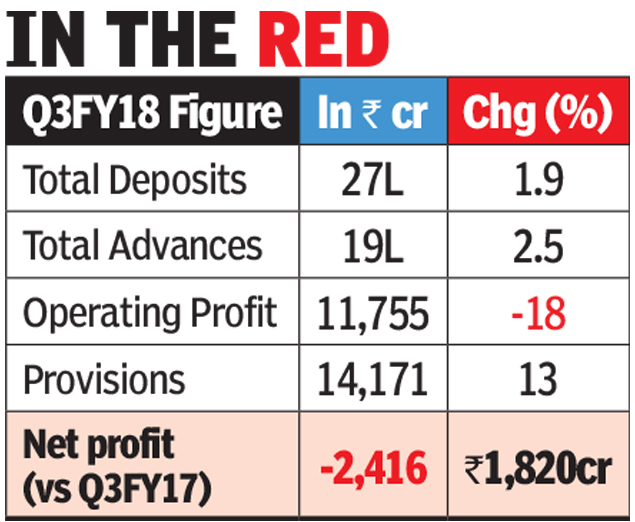State Bank of India
This is a collection of articles archived for the excellence of their content. |
Contents |
Bad loan cases, large
2018

From: Mayur Shetty, ‘Dirty dozen’ bankruptcy cases to be resolved in current fiscal: SBI, October 29, 2018: The Times of India
SBI expects the ‘dirty dozen’ large bad loan cases referred to the bankruptcy courts to be resolved by the end of the current fiscal. According to managing director Arijit Basu, the bankruptcy process has stabilised with several Supreme Court rulings and there is more clarity in the process.
“While the bankruptcy law came into place two years ago, cases had to be referred and a community of resolution professionals needed to be created. Today, there are some thousands of them. Many matters have been referred to the Supreme Court and in one of the judgments, besides speaking of a particular account, they have laid down the process very clearly,” said Basu.
He added that the process has stabilised as there is clarity on how the courts are required to move and on each of the players — the committee of creditors, the operational creditors and the resolution professionals. The timelines are also being met, he said.
The ‘dirty dozen’ refers to 12 of the largest defaulters in corporate India against which banks have been asked to initiate bankruptcy proceedings by the RBI. These 12 account for nearly Rs 2.8 lakh crore worth of bad loans and include the likes of Essar Steel, Bhushan Steel and Bhushan Power & Steel (see graphic).
According to Basu, even internationally, the resolution process does not necessarily happen within 270 days. “Broadly, anything getting resolved within a year compared to other alternative mechanisms is very significant,” he said.
Basu was speaking to TOI on the sidelines of the SBI Green Marathon in Mumbai — an event that the bank holds in each of the 16 cities where it has its local headquarters. “We are doing this because we believe that growth has to be sustainable. Many of our institutes and offices draw power from solar panels and we have discontinued single-use plastics,” said Basu.
While SBI stands to be the biggest gainer if the ‘dirty dozen’ cases are resolved, the bank also stands to lose if it has to take haircuts in resolution of power projects where the RBI has put its foot down and refused regulatory dispensation. The RBI’s opposition to easing of bad loan guidelines was reiterated by deputy governor Viral Acharya in a speech last week.
Profitability
2017-18/ Q3: 1st quarterly loss in 2 decades
February 10, 2018: The Times of India

From: February 10, 2018: The Times of India
HIGHLIGHTS
Country’s largest bank SBI on Thursday has reported its first quarterly loss in nearly two decades
Bad loans of the lender rose after the RBI directed the bank to classify loans worth Rs 23,000 crore, largely in the power sector, as non-performing asset
The country's largest bank SBI has reported its first quarterly loss in nearly two decades following a surge in provisioning for bad loans and losses on bond valuation. Bad loans rose after the RBI directed the bank to classify loans worth Rs 23,000 crore, largely in the power sector, as non-performing assets (NPAs).
The lender reported a net loss of Rs 2,416 crore for the quarter ended December 31, versus a profit of Rs 1,820 crore a year earlier. The quarter turned out to be the perfect storm for the bank as it was simultaneously hit by Rs 700-crore provisions towards imminent wage revisions and costs related to merger of associate banks with itself.
The rise in bond yields resulted in a double whammy for the bank — the value of bonds dipped by Rs 2,000 crore, requiring provisioning, and profits from trading in securities dipped to Rs 1,026 crore from Rs 4,900 crore in Q3FY17.
Overall, Rs 25,830 crore of fresh loans slipped into the NPA category. "We have done an account-by-account assessment and NPA provisions have peaked and will be coming down in subsequent quarters," said SBI chairman Rajnish Kumar.
According to Kumar, the large loan accounts against which the bank has initiated insolvency proceedings have advances amounting to Rs 78,000 crore. The bank has already made all the statutory provisioning in respect of these loans and most of these were expected to get resolved in the first quarter of FY19.
SBI has taken a tough stance against borrowers. In addition to initiating insolvency proceedings against them, the bank has invoked the personal guarantee of the promoters, Kumar said.
Announcing the results, Kumar said that 90% of the accounts that slipped into the NPA category were from those classified as stressed and there were no more stressed loans left. "We are at the end of the NPA cycle and the overall scenario looks very good," he said.
Another positive development according to Kumar was the shift in customer engagement to alternate (nonbranch) channels, which now account for 84% of all transactions — up from 76% earlier. "The benefits of the branch rationalisation that we have undergone will be felt in coming quarter," said Kumar.
SBI will also announce its new minimum balance requirement by the end of the month or early March. Kumar said that the bank is conducting an annual review of charges and was relooking at the minimum balance requirements as part of the review. "We will definitely keep in mind what our customers want," said Kumar.